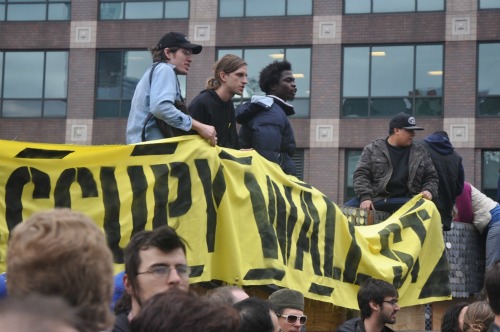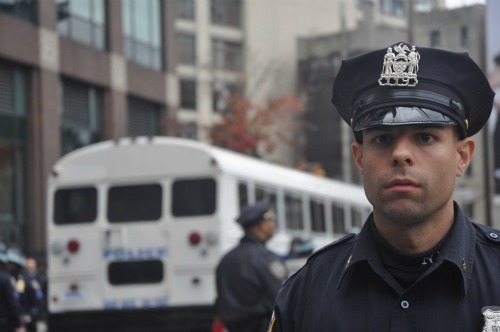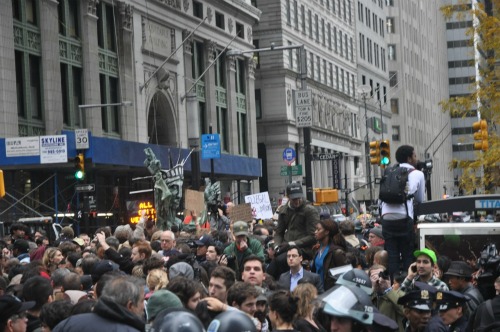 Protesters gathered this afternoon at 6th Avenue and Canal Street.Photo: Sarah GoodyearI woke up this morning to the news that the occupation of Zuccotti Park had been ended, and my first question was, “Where will all the people go?”
Protesters gathered this afternoon at 6th Avenue and Canal Street.Photo: Sarah GoodyearI woke up this morning to the news that the occupation of Zuccotti Park had been ended, and my first question was, “Where will all the people go?”
The strange legalities surrounding Zuccotti Park have been a critical factor in the development of the political statement that goes by the name “Occupy Wall Street.” The space itself enables, and to a certain extent defines, the action. Even as the movement has spread nationally, the New York encampment remains an important part of the movement’s identity.
But starting at 1 a.m. this morning, the protesters were removed, their tents and belongings loaded into garbage trucks and hauled away. Now comes the news that a judge has ruled that the protesters may return, but they cannot bring tents or generators. Technically, they will be allowed to stay 24-7, but the encampment is apparently over.
Without the permanent presence at Zuccotti Park, what will happen to Occupy Wall Street?
I spent much of the day following people who had been displaced from Zuccotti, riding my bike through the increasingly chaotic and traffic-choked streets of Lower Manhattan, where police vehicles of all sizes were a constant presence.
 Photo: Sarah GoodyearI started at Foley Square, a usually dead space surrounded by imposing courthouses about a half mile northeast of Zuccotti. There, a bleary-looking handful of folks huddled in sleeping bags or sat together in small groups talking. They all looked stunned.
Photo: Sarah GoodyearI started at Foley Square, a usually dead space surrounded by imposing courthouses about a half mile northeast of Zuccotti. There, a bleary-looking handful of folks huddled in sleeping bags or sat together in small groups talking. They all looked stunned.
Someone holding an information sign told me that a crowd was gathering at the corner of Canal Street and 6th Avenue in preparation for a march, about a mile and a half to the north. When I arrived there, a group of protesters had just been arrested after briefly occupying a vacant lot belonging to Trinity Church. After a quick General Assembly, most of the remaining protesters decided to head back to Zuccotti.
At about 4 p.m., we found the park empty, surrounded by metal barriers and police, many in riot gear. The crowd outside the gates grew and grew, blocking the sidewalk that surrounds the park, while the police looked out at them. The mood was mostly calm. The cops seemed bored as much as anything. Both sides waited to hear whether the judge would force the city to let the protesters back in for good.
At 5 p.m., word came down that the judge had sided with the city. As I write, protesters are streaming back into the park, but they will not be allowed to camp.
Watching the occupiers try to find their place today made me think of a huge flock of starlings startled from a tree, swirling around, coming together in small numbers before regrouping and resettling right back where they had begun.
 Afternoon chaos at Zuccotti. Photo: Sarah GoodyearIt won’t be easy to separate the OWS crowd from Zuccotti Park (or Liberty Park, as some people are calling it). Last night, as the police surrounded the park in preparation for clearing it, protesters began to chant: “Whose Park?” was the call. “Our Park!” came the response. Today, I heard many people refer to it as their home.
Afternoon chaos at Zuccotti. Photo: Sarah GoodyearIt won’t be easy to separate the OWS crowd from Zuccotti Park (or Liberty Park, as some people are calling it). Last night, as the police surrounded the park in preparation for clearing it, protesters began to chant: “Whose Park?” was the call. “Our Park!” came the response. Today, I heard many people refer to it as their home.
This somewhat bland and corporate space has taken on an emotional charge and significance for hundreds, if not thousands, of people. That is not going to dissipate immediately.
Becoming synonymous with an anti-establishment social movement is certainly not the outcome that Brookfield Properties, the owner of the space, envisioned when it brokered the deal that gave the company the right to build a bigger office tower in exchange for the park. It’s doubtless not the kind of tribute the company intended to pay to its U.S. chairman, John Zuccotti (who, according to Wikipedia, has served at various times on both the National Republican Congressional Committee and Joe Biden’s presidential campaign).
But that’s the way cities work. They don’t belong to any one group, and they can never be fully controlled. They are a medium in which change happens, some of it bad, but much of it good. They are places where unexpected beauty and meaning can spring up between the cracks of the urban structure.
For several weeks now, organizers have been looking for ways to move the movement past occupation into different kinds of action. Crackdowns on encampments around the country might speed that process. The first real test will come on Thursday, when protests marking the two-month anniversary of the occupation are planned.
The movement has always intended to reach beyond the boundaries of Zuccotti Park. As powerful and useful as that place has been, if the force behind OWS is as powerful as its organizers believe, it will soon spring up somewhere else.




